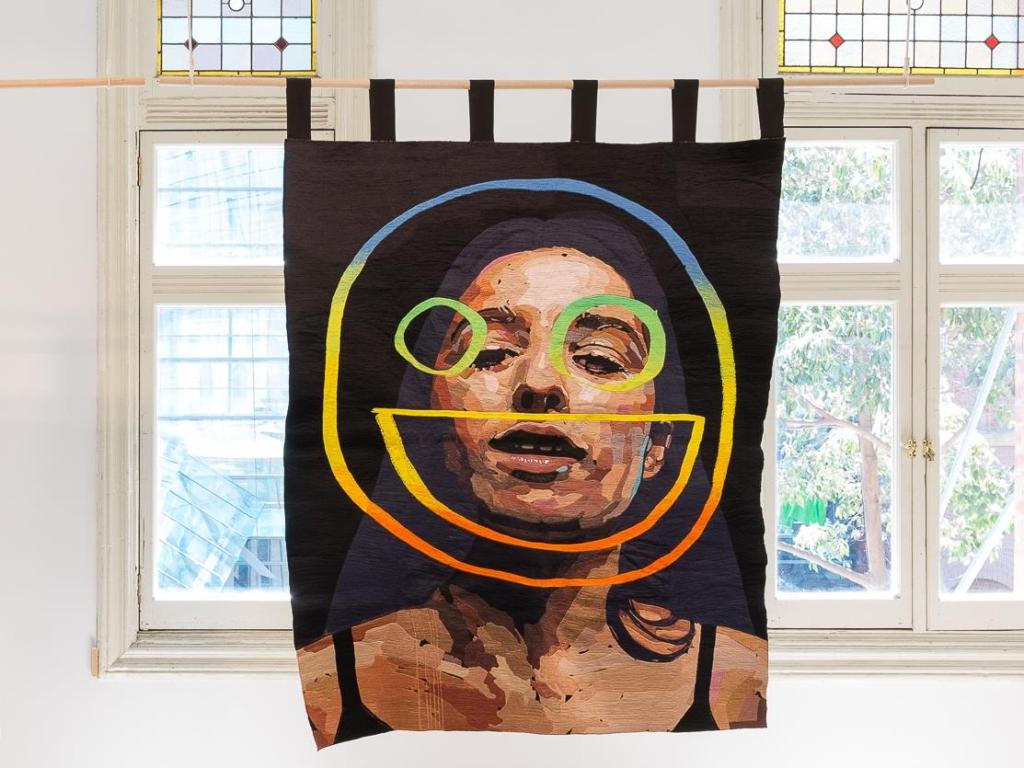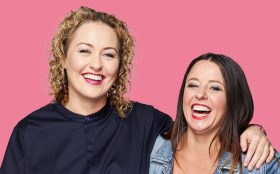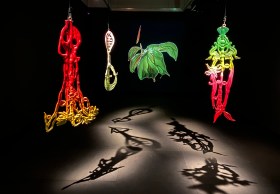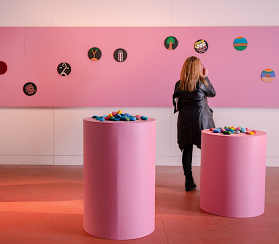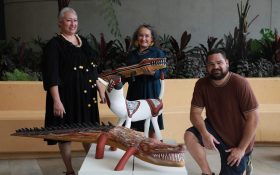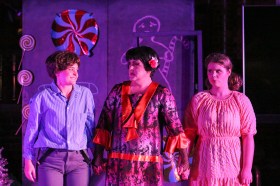Abdul Abdullah, Don’t worry, 2016 and Be Happy, 2016. Installation view as part of Jogja Calling, 4a Centre for Contemporary Asian Art; Courtesy of the artist and Fehily Contemporary. Made with the assistance of DGTMB Art Embroidery. Photo: Document Photography
Ideas festivals are full of buzzwords and you’ll find that everyone is always an innovator, influencer, trendsetter, provocateur or cultural leader. But despite the labels, these events remain popular because not only have we entered an era of sharing, but quite simply, good advice helps.
‘Somewhere in all those buzzwords there is what we do, and that is to engage with the real world,’ said Vic McEwan, Artistic Director of The Cad Factory, an innovative arts organisation that moved from the inner-city suburb of Marrickville to regional Narrandera in 2009.
McEwan will be speaking as part of a Shapeshifter panel discussion for the Vivid Ideas Exchange, one of three dynamic conversations staged by the NSW Government’s new arts and cultural agency, Create NSW in order to support the professional career development of artists across the State.
Shapeshifter: Reframing Art and Screen Culture will be a conversation that explores the contemporary role of the artist and their commitment to bold, authentic storytelling, while the panel Fame and Fortune will unpack strategies on how to make your artistic practice more sustainable, offering take-away tips and covering everything from the emotional, the political, to the practical.
Short change for real change
Labels don’t mean a great deal out in Narrandera, but how art can impact a community does. McEwan explained: ‘It was a big shift from an industrial city factory to being 30km out of a country town surrounded by fields.’
He continued: ‘What we are aiming to do is always changing. That might make us innovative, for example, but sometimes it is little snippets of all those buzzwords that we are at any one time, and that means you can find the unique outcomes that are particularly relevant to an individual or a situation.’
McEwan was the recipient of the Inaugural Arts NSW Regional Fellowship for 2014/16 and sits on the Inaugural NSW/ACT Arts/Health State Leadership Group and board of Music NSW. His philosophy at The Cad Factory is to embed art into the every day.
‘From my perspective in the last five years there has been massive change in the possibility of work that artists can get involved in creatively. I think there is starting to be a shift in Australia that recognises the relevance that creative work can also have some social good.’
Shapeshifter: Create NSW – Reframing Art and Screen Culture will be presented at the Museum of Contemporary Art Australia, Sydney on 30 May, 5 – 7pm, as part of Vivid Ideas Exchange. Free, registration required.
The panel will feature a line-up of tenacious artists celebrated for producing work that is both hyper-local and internationally resonant, and will hone in on authentic storytelling as a means to affect change.
Amongst those joining McEwan is Fairfield based Ali Kadhim, a Parkour practitioner, film maker, community art facilitator, and martial artist.
For Kadhim, crossing the boundaries of arts and screen practices is something he has grown into. ‘I was fortunate to start very early. The 13 years of martial arts I did growing up is now helping me to visualise and choreograph fight and action scenes for films, and my parkour training adds to the action and story design. I see things in pictures and I enjoy being able to translate those pictures to the screen.’
Also on the panel will be Nakkiah Lui, an Australian writer (Kill the Messenger, Black is the New White, Black Comedy) and actor (Black Comedy) and designer and artist Alison Page. Leading the panel through the discussion is ABC’s Zan Rowe.
This is not a game show
‘Fame and Fortune – it sounds more like a game show, but hey we are talking about the arts,’ said Nicole Monks with a laugh. She is part of a panel hosted in partnership with the Art Gallery of NSW targeting an audience of professional artists.
‘Fame and fortune is not why I do what I do. The reason I create is because I am compelled to – I do it for my culture. It is a practice more than a career, and it’s about creating a better future for our next generation,’ she said.
Nicole Monks is the Creative Director of blackandwhite creative, a company she formed in 2012 to weave Aboriginal philosophies of sustainability, innovation and collaboration into contemporary art and design projects.
‘Sustainability for me is a way of being and understanding the earth, in my practice I use sustainable and eco-friendly materials and design ethically,’ she said.
Monks started her career in retail interior design, which taught her all about waste. ‘Every five years you had to do a total refit because trends change. What I have tried to do is to use those skills but redirect them.’
Monks will be joined by artists, arts and cultural workers across different platforms, including Bree Pickering, Rebecca Conroy, Abdul Abdullah, Alex Wisser and Toby Chapman. The panel will be facilitated by Create NSW Engagement & Partnerships Lead (and artist) Nat Randall.
This event has a practical workshop element that will arm participants with some strategies that they can walk-away and implement to help manage their creative careers. Heather Whitely Robertson, Head of Learning and Participation AGNSW, will lead that creative brainstorming session.
Fame and Fortune – sustaining your artistic practice will be presented at the Art Gallery of NSW on 3 June, 10am – 12.30pm. This is a ticketed event.
Facing professional challenges
Whether a theatre maker in regional NSW or an ethical Indigenous designer in inner Sydney, the challenges are shared and real.
McEwan said that one of the biggest he faces living and working in region Australia is exposure. ‘We typically get a lot of touring arts products. What people don’t have a lot of exposure to here is process. Social media is a great way for people on the fringes of process to peer inside from the comfort of their lounge room before talk to the scary artist.’
He continued: ‘Also, as we are regional, unless we document things and know how to share them, people have no idea of what is happening here. It is exciting to be connected internationally while living remotely. What has come of that is that people travel to see our work, and I am contacted every couple of months with questions on making that kind of work and its benefit in aiding a community.’
For Monks, the biggest challenge for her is not connections or cultural, but rather financial.
‘At the moment art pays for me to attend something or go somewhere but there is not a lot left over to even keep practicing. When you start your own business people see that you are 100 per cent behind what you are doing.’ she said. If people see that you’ll back yourself then they feel confident too as well.
‘As an urban Aboriginal artist and designer one of the hardest things has been creating a business where nothing exists like it. For example, no one is doing commercial Indigenous furniture – there is no guidebook,’ said Monks.
To find the answers she looks back to Aboriginal culture and how innovative it has been for tens of thousands of years. ‘to create a shield you only need to take part of a tree so you don’t kill the tree – it is a good practice that can be applied to contemporary business. Aboriginal people are the true pioneers of sustainability.’
McEwan echoed Monks words: ‘I think our key function at The Cad Factory is to do whatever we want with ethical consideration. For example, if I decide I want to work with some farmers on an idea, ethically it’s not just about taking people’s stories. It is about creating an organisation where artists can make work, but with consideration of place and community they are working with.’
Pick the bubble
Monks believes that we need to look outside of our bubble to push through the barriers. I would like Aboriginal design seen in the everyday built environment, to start a conversation to be had by all Australians, about First Nations people.’
‘I love saying yes to opportunities and love being part of something, but at times your body will just say, “too much – you can’t do it”. The work I do has a message and a context, and I try not to compromise those things. On top of that balance, I just had a baby and when you have a family you want to work on projects that will make positive change for their future, she said.
While fame, fortune and being a shapeshifter has a certain 21st century panache to it, success is short lived unless you work at it.
This sentiment is shared by fellow panelist and interdisciplinary creative Rebecca Conroy who works across site, community engagement, and performative interventions through artist led activity.
What would she say to mid-career artists fighting to keep their fire alive? ‘Collectivise! Work together! Work against the grain, but work against it together. Also stay connected to an international network of artist communities; I find this inspiring and necessary fuel. It can get quite suffocating and conservative in one place.’
‘As they say in finance, diversify your portfolio! I am not a big fan of working in the arts as an “artist” 100 per cent of time; I think its healthier to mix gardening, or cooking, or laundry, or some other trade alongside your art practice,’ she continued.
Adding advice to emerging practitioners on capturing their motivation, Kadhim said, ‘Everything you do starts with you. Nobody can do your work for you. I believe you should be very specific about what you love and then believe in your ability to do what you love to a high level. Outside encouragement helps but is not necessary. Your inner voice is more important – you’ve got to listen to yourself day and night while outside voices just come and go. Might as well make your thoughts positive.’
These Create NSW panel discussions as part of the Vivid Ideas Exchange chart the success and challenges of artists and creatives working today. This is not just a textbook case study, or an accountancy degree offering a clear career path. As Monks put it: ‘It’s a full bleed. My coffee table looks like my studio! When your practice is your cultural expression, it is in everything that you do.’
As McEwan concluded: ‘The reason artists are primed to work in these areas is because art is primarily about communication, and to do that in a way that is meaningful. It doesn’t need to be issues based. In arts practice it can be very personal, that is a very important part of our existence.’
Michael Brealey, CEO of Create NSW adds, ‘Open conversations like these are essential in showing artists just how much can be achieved by sharing knowledge and experience. Through Create NSW, we aim to help artists identify appropriate support whether that’s through funding or simply through putting artists in touch with key creative and art form leaders.’
For more details visit Create NSW.
